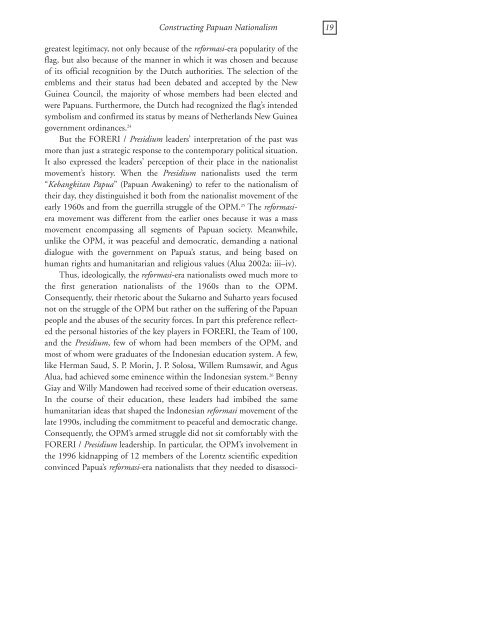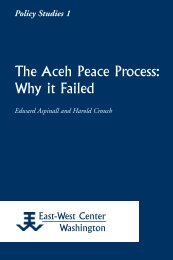Constructing Papuan Nationalism: History, Ethnicity ... - ScholarSpace
Constructing Papuan Nationalism: History, Ethnicity ... - ScholarSpace
Constructing Papuan Nationalism: History, Ethnicity ... - ScholarSpace
- No tags were found...
You also want an ePaper? Increase the reach of your titles
YUMPU automatically turns print PDFs into web optimized ePapers that Google loves.
<strong>Constructing</strong> <strong>Papuan</strong> <strong>Nationalism</strong> 19greatest legitimacy, not only because of the reformasi-era popularity of theflag, but also because of the manner in which it was chosen and becauseof its official recognition by the Dutch authorities. The selection of theemblems and their status had been debated and accepted by the NewGuinea Council, the majority of whose members had been elected andwere <strong>Papuan</strong>s. Furthermore, the Dutch had recognized the flag’s intendedsymbolism and confirmed its status by means of Netherlands New Guineagovernment ordinances. 24But the FORERI / Presidium leaders’ interpretation of the past wasmore than just a strategic response to the contemporary political situation.It also expressed the leaders’ perception of their place in the nationalistmovement’s history. When the Presidium nationalists used the term“Kebangkitan Papua” (<strong>Papuan</strong> Awakening) to refer to the nationalism oftheir day, they distinguished it both from the nationalist movement of theearly 1960s and from the guerrilla struggle of the OPM. 25 The reformasieramovement was different from the earlier ones because it was a massmovement encompassing all segments of <strong>Papuan</strong> society. Meanwhile,unlike the OPM, it was peaceful and democratic, demanding a nationaldialogue with the government on Papua’s status, and being based onhuman rights and humanitarian and religious values (Alua 2002a: iii–iv).Thus, ideologically, the reformasi-era nationalists owed much more tothe first generation nationalists of the 1960s than to the OPM.Consequently, their rhetoric about the Sukarno and Suharto years focusednot on the struggle of the OPM but rather on the suffering of the <strong>Papuan</strong>people and the abuses of the security forces. In part this preference reflectedthe personal histories of the key players in FORERI, the Team of 100,and the Presidium, few of whom had been members of the OPM, andmost of whom were graduates of the Indonesian education system. A few,like Herman Saud, S. P. Morin, J. P. Solosa, Willem Rumsawir, and AgusAlua, had achieved some eminence within the Indonesian system. 26 BennyGiay and Willy Mandowen had received some of their education overseas.In the course of their education, these leaders had imbibed the samehumanitarian ideas that shaped the Indonesian reformasi movement of thelate 1990s, including the commitment to peaceful and democratic change.Consequently, the OPM’s armed struggle did not sit comfortably with theFORERI / Presidium leadership. In particular, the OPM’s involvement inthe 1996 kidnapping of 12 members of the Lorentz scientific expeditionconvinced Papua’s reformasi-era nationalists that they needed to disassoci-
















